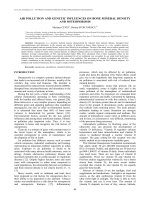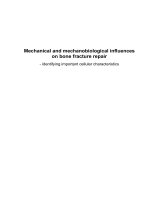big bone lick
Bạn đang xem bản rút gọn của tài liệu. Xem và tải ngay bản đầy đủ của tài liệu tại đây (4.09 MB, 201 trang )
Big
Bone Lick
Stanley Hedeen
Big
Bone Lick
The Cradle of American Paleontology
Foreword by John Mack Faragher
THE UNIVERSITY PRESS OF KENTUCKY
Frontispiece: Museum exhibit depicting Big Bone Lick at the end of the Ice Age.
(Cincinnati Museum Center)
Copyright © 2008 by The University Press of Kentucky
Scholarly publisher for the Commonwealth,
serving Bellarmine University, Berea College, Centre
College of Kentucky, Eastern Kentucky University,
The Filson Historical Society, Georgetown College,
Kentucky Historical Society, Kentucky State University,
Morehead State University, Murray State University,
Northern Kentucky University, Transylvania University,
University of Kentucky, University of Louisville,
and Western Kentucky University.
All rights reserved.
Editorial and Sales Offices: The University Press of Kentucky
663 South Limestone Street, Lexington, Kentucky 40508-4008
www.kentuckypress.com
12 11 10 09 08 5 4 3 2 1
Library of Congress Cataloging-in-Publication Data
Hedeen, Stanley.
Big Bone lick : the cradle of American paleontology / Stanley Hedeen ;
foreword by John Mack Faragher.
p. cm.
Includes bibliographical references and index.
ISBN 978-0-8131-2485-8 (hardcover : alk. paper)
1. Paleontology—Kentucky—Big Bone. 2. Mammoths—Kentucky—Big Bone.
3. Mastodons—Kentucky—Big Bone. 4. Mammals, Fossil—Kentucky—Big
Bone. 5. Fossils—Kentucky—Big Bone. 6. Big Bone (Ky.) History. I. Title.
QE705.U6H43 2008
560.9769’363—dc22
2007040474
This book is printed on acid-free recycled paper meeting
the requirements of the American National Standard
for Permanence in Paper for Printed Library Materials.
Manufactured in the United States of America.
Member of the Association of
American University Presses
To Glenn Storrs,
W ithrow Farny Curator of Vertebrate Paleontology,
Cincinnati Museum Center
List of Illustrations ix
Foreword xi
Acknowledgments xv
Introduction xvii
1. Geologic Setting 1
2. Source of Salt and Health 8
3. Indian Accounts of Great Buffalo 20
4. Gathering the Bones 31
5.
Animal Incognitum 45
6. Thomas Jefferson Takes an Interest 56
7. A Question of Tusks 69
8. William Goforth’s Stolen Specimens 83
9. William Clark’s Bountiful Collection 96
10. The Faunal List Evolves 112
11. Other Mammoth Changes 123
12. Agents of Extinction 138
Notes 151
Index 175
Contents
Figures
Depiction of Big Bone Lick at the end
of the Ice Age Frontispiece
1. Relationship between surface bedrock and the
Cincinnati Arch 2
2. Preglacial drainage of the Cincinnati region
approximately 2 million years ago 3
3. Glacial limits in the Cincinnati region 5
4. Map of Big Bone Lick in 1830 12
5. William Clark 14
6. American bison 22
7. Bison horns are shaped like tusks 26
8. Forty-inch-long femur collected at Big Bone
Lick in 1739 32
9. Detail from 1755 edition of Jacques Nicolas Bellin’s
1744 map Carte de la Louisiane etc. 34
10. Molar collected at Big Bone Lick in 1739 36
11. Surface view of the molar in figure 10 and the
molar of an Asian elephant 36
12. Molar from Big Bone Lick sent to Buffon by
Collinson 49
13. French naturalist Georges-Louis Leclerc
de Buffon 54
14. Ezra Stiles 59
Illustrations
ix
15. Thomas Jefferson 66
16. Posterior fragment of an upper jawbone collected
at Big Bone Lick 71
17. Detail from John Filson’s 1784
This Map of
Kentucke, etc. 73
18. Tusk fragment, molar, and femur collected at
Big Bone Lick by Isaac Craig 74
19. French scientist Georges Cuvier 77
20. Meriwether Lewis 89
21. Elephant-like molar 94
22. Cuvier’s 1806 drawing of a mastodon skeleton 98
23. Fragment from a mastodon’s lower jawbone
collected at Big Bone Lick by William Clark 102
24. Skull of an elk-moose collected at Big Bone Lick
by William Clark 105
25. Skeleton of an elk-moose 106
26. Skull of a helmeted musk ox collected at Big
Bone Lick by William Clark 107
27. Sculpture of a female helmeted musk ox and calf 108
28. Horn core of an ancient bison collected at Big
Bone Lick by William Clark 109
29. Sculpture of a Jefferson’s ground sloth 116
30. Sculpture of a Harlan’s ground sloth 118
31. English geologist Charles Lyell 124
32. Woolly mammoth 132
33. American mastodon 135
34. Sculptures of flat-headed peccaries 136
35. Diagrammatic cross section based on excavations
at Big Bone Lick 139
36. Clovis projectile points collected at Big Bone Lick 147
37. Carolina parakeet captured at Big Bone Lick, and
three warbler species 148
Table
Mammal species excavated at Big Bone Lick 143
Illustrations
x
In 1784, Delaware schoolmaster John Filson published The Dis-
covery, Settlement, and Present State of Kentucke, a tract promot
-
ing the trans-Appalachian West as the new “land of promise,
flowing with milk and honey,” and introducing readers to “The
Adventures of Col. Daniel Boon.” As a result, both Kentucky
and Boone were soon famous—Kentucky as the first of many
western American promised lands, and Boone as the archetypal
man who led the way to them.
Filson offered something for everyone, packing his pages
with descriptions of the many strange and curious things to be
seen in the new West. None proved more interesting than the
fossilized remains found at Big Bone Lick, a salt spring in what
is now Boone County, near the Ohio River. Filson had visited
the site himself soon after his arrival in Kentucky. The fossils he
saw there were awesome: huge femur and rib bones, great ivory
tusks, jawbones wider than the span of a man’s arms, molars the
size of pumpkins. These remains, Filson told his readers, ex-
ceeded “the size of any species of animals now in America.”
Specimens had already been collected and sent to Paris, Lon
-
don, and Philadelphia, where they “excited the amazement of
the ignorant, and attracted the attention of the philosopher.”
They posed difficult questions. To what animal did they be-
long? Natives told “marvelous stories” about great beasts, but
how could men of science trust such legends? The bones bore a
Foreword
xi
Foreword
xii
resemblance to those of the elephant, but elephants were native
to “the torrid zone” and could not possibly survive the frigid
North American winters. Some authorities, Filson reported, ar
-
gued that they were the remains of “a quadruped now unknown,
and whose race is probably extinct,” perhaps by the hand of
man. “Can then so great a link have perished from the chain of
nature?” It was all very perplexing. “These are difficulties,” Fil
-
son concluded, “sufficient to stagger credulity itself.”
Stanley Hedeen’s delightful history recounts the fascinating
story of the Big Bone Lick fossils. The tale moves far from Ken-
tucky and includes a remarkable cast of characters. The site was
well known to the native peoples of the Ohio Valley. Europeans
first saw it in 1739, and soon specimens were being sent east and
across the Atlantic. A number of Big Bone Lick fossils were de
-
posited in the collections of the American Philosophical Society
in Philadelphia; others resided in the Cabinet du Roi, the French
king’s collection of curiosities in Paris. Bones and teeth sent to
London sparked debates before the Royal Society. The fossils
even found their way into the Tammany Society’s museum in
New York City. Leading Americans such as Benjamin Franklin,
George Washington, and Thomas Jefferson avidly sought spec
-
imens of their own.
The lust for these bones was, in part, simply a desire to see
and touch something so spectacular. But as Filson’s account
suggests, there was also considerable controversy over the inter
-
pretation of the fossils. The Shawnee believed that they were
the remains of man-eating monsters destroyed by a benevolent
God to protect the Indian people. A noted British anatomist
and physician to the queen agreed that they were the bones of a
vanished species. “As men,” he wrote, “we cannot but thank
Heaven that its whole generation is probably extinct.” But oth-
ers, committed to a belief in the perfection of God’s creation,
found it hard to accept the notion of extinction. Thomas Jef
-
ferson thought that the very concept violated the inherent bal
-
Foreword
xiii
ance of nature, and he pondered the problem for many years. In
the last months of his presidency, Jefferson commissioned Wil
-
liam Clark, lately returned from his transcontinental explora
-
tion with Meriwether Lewis, to excavate and ship a large sampling
of Big Bone Lick fossils to Washington. Hedeen’s description of
Jefferson laying out the bones in the East Room of the White
House is only one of the many arresting images in this remark
-
able history.
Eventually, people made sense of the findings. Hedeen,
himself a biologist, gives us the science as well as the history.
His narrative strategy is simple but effective, letting the char
-
acters speak in their own voices, encouraging us to listen care
-
fully to what the people of the past had to say. It makes for
great reading.
John Mack Faragher
Arthur Unobskey Professor of American History
Yale University
xv
I would like to thank Linda Lotz, Richard Davis, Greg Mc Don-
ald, and Paul Semonin for their many suggestions for improv
-
ing this book. A great deal of gratitude goes to Sidnie Reed for
arranging numerous loans of library materials, and to John
Mack Faragher for writing the foreword. Credit is also given to
Greg Rust, Joe Higgins, and Kathy Hedeen for their assistance
with the illustrations. Finally, special appreciation is extended
to the professional and courteous staff of the University Press of
Kentucky, especially Laura Sutton, Joyce Harrison, Ann Mal
-
colm, Ila McEntire, and Will McKay.
Acknowledgments
xvii
As no other place hitherto discovered in the Union has af-
forded such quantities of huge animal remains, . . . the
tomb of the mammoths will certainly reward the traveler
of taste and science.
—Daniel Drake, 1815
Big Bone Lick, “the tomb of the mammoths,” became a Ken-
tucky state park in 1960. Although not as well known as the
state’s Mammoth Cave National Park, the salt lick is an equally
important geologic, biologic, and historic location. Most nota-
bly, the uncovering of the Lick’s fossil bones called attention to
the fact that certain animals had vanished from the planet.
Several American Indian nations knew of Big Bone Lick
prior to its “discovery” by a French military party in 1739. Skel
-
etal specimens taken from the site by the French commander
were placed in the king’s natural history collection in Paris,
where they were studied by celebrated naturalists Georges-
Louis Leclerc de Buffon and Georges Cuvier. Kentucky fron
-
tier notables such as Daniel Boone, Mary Ingles, and George
Rogers Clark viewed the large bones at the Lick during the lat
-
ter half of the eighteenth century. Visitors gathered fossils from
the location and provided them to Benjamin Franklin, George
Washington, and other prominent individuals. Captain Wil-
Introduction
Introduction
xviii
liam Henry Harrison, the future U.S. president, collected sev-
eral barrels of fossils from the site.
Meriwether Lewis took bones from the Lick in the year pri
-
or to the 1804–1806 Lewis and Clark expedition, and his part
-
ner, William Clark, gathered hundreds of specimens in the year
following the excursion. President Thomas Jefferson sponsored
the activities of Lewis and Clark at the Lick, so some of the site’s
bones ended up at Jefferson’s Monticello home. British scientist
Charles Lyell, the “father of geology,” made a pilgrimage to the
famous Lick in 1842. Parties of university paleontologists
amassed fossil troves for Harvard in the 1860s and Nebraska in
the 1960s, and other collectors unearthed pieces for city, state,
and national museums. A large number of American and foreign
institutions house the thousands of fossil specimens that have
been recovered from Big Bone Lick.
The purpose of this book is to present the remarkable story
of the birthplace of American paleontology. The volume begins
with an overview of the Lick’s geology and its past human use as
a source of salt and supposedly healthful mineral waters. The
major portion of the text details the numerous discoveries of
animal skeletal pieces, many of which were initially misidenti
-
fied or misrepresented. The specimens collected from the Lick
have been well characterized as the fossils “of which fame had
said so much, the learned risked so many conjectures, and every
body knew so little.”
1
Finally, the last chapter examines the pos-
sible reasons for the disappearance of the site’s extinct species
and concludes with a description of how the salt lick’s suspected
source of brine might help prevent a future extinction event.
This is the second book bearing the title Big Bone Lick. The
first text, a 1936 monograph by Willard Rouse Jillson, was spon
-
sored by the Big Bone Lick Association. The present incarnation
of the association is the Friends of Big Bone, a nonprofit group
committed to providing education and conducting research at
the Lick. Interested readers can contact the organization through
its Web site or through the office at Big Bone Lick State Park.
1
The most basic principle of geology is the Principle of
Change. Given enough time, all things change. Thus also
Big Bone.
—R. A. Davis, 1981
The eminent English geologist Charles Lyell visited the Cin-
cinnati area in 1842 to collect two groups of fossils: mammal
bones from Big Bone Lick, and marine shells from the bedrock
of the region. Half a century earlier, upon discovering that the
area’s bedrock debris was “full of petrifactions of seashells,”
French naturalist André Michaux had concluded that the bones
at the Lick were probably the remains of oceanic animals. Most
early visitors to the Lick, however, correctly identified the site’s
bones as those of mammals that had lived on land sometime
after the sea’s disappearance from the Cincinnati region.
1
Geologists today employ fission-track analysis, electron spin
resonance, radiometric dating, and other techniques to estimate
age. These methods have established that the Cincinnati area’s
marine invertebrate fossils are approximately 450 million years
old, while the terrestrial mammal fossils at the Lick are less
than 20,000 years old. Investigators have not yet determined
the period when the Cincinnati area rose above sea level, but
they have constructed a scenario of the region’s emergence and
its subsequent geologic history.
2
Geologic Setting
Chapter 1
Big Bone Lick
2
The region’s exposed fossiliferous strata started out about
450 million years ago as layers of bottom sediment in an ocean of
the Ordovician period. Below the surface bedrock are sedimen
-
tary rock layers that were deposited earlier in oceans and tidal
flats. One of these marine layers, possibly the pre-Ordovician
Mount Simon Sandstone or the Ordovician St. Peter Sandstone,
is the likely source of the sulfurous brine that flows from the salt
springs at Big Bone Lick.
3
Following the Ordovician period, oceans continued to cover
the area for untold millions of years. The region eventually
emerged above sea level when the portion of the continental
plate below the Cincinnati area bulged upward. Today, the re-
Figure 1. Relationship between surface bedrock (top map) and the Cincinnati Arch
(bottom cross section). (Adapted from Kenneth E. Caster, Elizabeth A. Dalve, and
John K. Pope, Elementary Guide to the Fossils and Strata of the Ordovician in the Vicin
-
ity of Cincinnati, Ohio [1961], 11)
Geologic Setting
3
Figure 2. Preglacial drainage of the Cincinnati region approximately 2
million years ago. (Adapted from James T. Teller, “Preglacial [Teays]
and Early Glacial Drainage in the Cincinnati Area, Ohio, Kentucky,
and Indiana,” Geological Society of America Bulletin 84 [1973]: 3679, and
Frank R. Ettensohn, “The Pre-Illinoian Lake Clays of the Cincinnati
Region,” Ohio Journal of Science 74 [1974]: 215)
gion still rests on the crest of the uplift, known as the Cincin-
nati Arch (figure 1). Erosion has removed the marine sediments
that were deposited in the area after the Ordovician period.
4
About 2 million years ago, just prior to the Pleistocene ep-
och, or the Ice Age, the Cincinnati area had a rolling to flat
surface that was drained by low-gradient streams (figure 2).
Modern evidence of the courses of these preglacial waterways is
Big Bone Lick
4
provided by stream sediments located just below the surface of
today’s uplands, as well as by paleochannels etched into the up
-
lands. Investigators have found that the area’s major preglacial
streams flowed north, perhaps following underlying fault lines.
Because streams seek the path of least resistance, they follow
zones of weakness created by fractures in the earth’s crust.
5
Stream deposits from the preglacial Old Kentucky River are
situated on the uplands near Big Bone Lick. In addition, a pos
-
sible paleochannel of the preglacial Old Eagle Creek is found on
these uplands, indicating that the Lick may be located near the
site of the Old Eagle Creek’s mouth on the Old Kentucky River.
The occurrence of a preglacial stream channel in the vicinity of
the Lick may be due to the subsurface fractures in the area.
These fractures, which extend downward into the underlying
sedimentary rock layers, serve as conduits for the sulfurous
brine that surfaces in the Lick’s springs.
6
From the vicinity of the Lick, the Old Kentucky River con-
tinued northward, absorbing the Old Licking River as well as
smaller streams. Some geologists theorize that the Old Ken
-
tucky River ran north all the way to the Erie Basin lowland.
Others believe that the river emptied into a large east-west
stream (the Teays River) that flowed across central Ohio, Indi-
ana, and Illinois to drain into the Mississippi River in the vicin
-
ity of St. Louis.
7
At least three Ice Age glaciers visited the Ohio River Valley:
the pre-Illinoian, the Illinoian, and the Wisconsinan. Between
1 million and 2 million years ago, the southward advance of the
pre-Illinoian glacier blocked the channel of the north-flowing
Old Kentucky River. The same continental ice sheet also blocked
the channels of other north-flowing streams located between
the Cincinnati area and the Appalachian Highlands to the east.
The glacial ice acted as a dam, causing lakes to form in the
stream valleys. As each lake filled, it overflowed into the next
lake, which subsequently overflowed into the next one, and so
Geologic Setting
5
on, until the Ohio River drainage system to the west was formed
along the margin of the ice sheet.
8
When the pre-Illinoian ice sheet pushed into northern Ken-
tucky, the glacier blanketed the site of Big Bone Lick, choked
the northern portion of the Old Eagle Creek channel, and di
-
verted the Ohio River southward around the edge of the ice.
Figure 3. Glacial limits in the Cincinnati region. (Adapted from Louis L. Ray,
“Geomorphology and Quaternary Geology of the Glaciated Ohio River Valley—
A Reconnaissance Study,” U.S. Geological Survey Professional Paper 826 [1974],
plate 1)
Big Bone Lick
6
The boundary of the ice sheet was located several miles to the
south and east of the Lick at the time of the glacier’s maximum
advance (figure 3). Following the retreat of the glacier, the Ohio
River cut its present valley near the Lick, and Eagle Creek es-
tablished its current channel about ten miles southwest of the
Lick.
9
The pre-Illinoian glacial age was followed by an interglacial
span of several hundred thousand years. During this interglacial
age, the Big Bone Creek drainage system formed in the north
-
ern Kentucky region that had been drained by the preglacial
Old Eagle Creek. Big Bone Lick is located along the valley floor
of Big Bone Creek, about three miles from the stream’s mouth
on the Ohio River.
Approximately a quarter million years ago, the Cincinnati
region was again visited by a continental ice sheet. This next-to-
last glacier to reach the region is called the Illinoian because the
first evidence of its existence was found in Illinois. Unlike the
pre-Illinoian glacier, the Illinoian either did not cover Big Bone
Lick or did not leave lasting indications of any landscape modi
-
fications at the site. The nearest glacial debris deposited by the
Illinoian ice sheet is located about half a mile northwest of the
Lick.
10
The Illinoian glaciation gave way to a warmer interglacial
period that lasted until the advent of the Wisconsinan glacial
age. The Wisconsinan glacier, the last North American ice
sheet, pushed into the Cincinnati region approximately 70,000
years ago and began its retreat about 19,500 years ago. This gla
-
cier stopped well short of Big Bone Lick—its nearest lobe stalled
approximately thirty miles north of the site. Nevertheless, out
-
wash materials from the Wisconsinan glacier had a large influ
-
ence on the Lick’s present topography.
11
Wisconsinan glacier meltwater and debris poured into the
Ohio River through streams located from New York to Indiana.
At Big Bone Creek and other Ohio River tributaries, glacial









